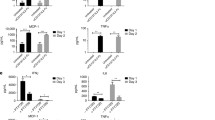Abstract.
A variety of human cancers overexpress a cell surface receptor with high affinity for the vitamin, folic acid (K d ~10–10 M). Covalent attachment of therapeutic agents to folic acid has been shown to allow efficient targeting of the folate–drug conjugates to folate receptor-expressing cancer cells, with little or no uptake by normal tissues except the kidneys. We report here the use of folate's ability to deliver attached molecules specifically to cancer cells to convert poorly immunogenic tumors into highly immunogenic tissue targets. By linking folic acid to a model hapten, we have been able to decorate folate receptor-expressing cancer cell surfaces with >106 haptens/cell in vivo. Following marking of such cells with haptens, the cells are observed to become opsonized with autologous anti-hapten antibodies, which is presumed to mediate cell removal via antibody-dependent cellular cytotoxicity (ADCC). Supplemental administration of low levels of ADCC-activating cytokines [e.g. interleukin-2 (IL-2) and interferon-alpha (IFN-α)] has been shown to synergize with the folate-targeted immunotherapy. Thus, using M109 syngeneic lung cancer cells injected intraperitoneally into Balb/c mice that were previously immunized against fluorescein, a significant extension of life span is observed following treatment with folate–fluorescein conjugates, and complete cures are observed upon supplementation with moderate levels of IL-2 and IFN-α. Because control tumor-bearing mice treated with the same cytokines but with non-targeted fluorescein show no extension of life span, we conclude that tumor-specific opsonization is an essential step in this immunotherapy. Finally, because the anti-fluorescein antibodies are unable to access the folate receptors on the apical membranes of the kidney proximal tubules, no kidney or other normal tissue cytotoxicity is observed. These data suggest that retargeting of haptens to folate receptor-expressing cancers might constitute a method for mobilizing the immune system specifically against poorly immunogenic tumors.
Similar content being viewed by others
Author information
Authors and Affiliations
Additional information
Electronic Publication
Rights and permissions
About this article
Cite this article
Lu, Y., Low, P.S. Folate targeting of haptens to cancer cell surfaces mediates immunotherapy of syngeneic murine tumors. Cancer Immunol Immunother 51, 153–162 (2002). https://doi.org/10.1007/s00262-002-0266-6
Received:
Accepted:
Issue Date:
DOI: https://doi.org/10.1007/s00262-002-0266-6




